Are you thinking of donating your hair? There are several organizations and programs that can turn your long locks into free or low-cost wigs for people with cancer. A wig can give confidence, strength, and hope to someone struggling with the emotional challenges of hair loss. Here’s how to make the nicest cut of all:
1. choose where to send your hair.
Each hair donation organization has its own mission and goals. Do some research to make sure you are comfortable with who gets the wigs and how. For example, Love Locks, Children’s Wigs, Chai Lifeline, and Hair Loss Children focus on children who have lost their hair due to cancer or another medical reason. some organizations serve specific states, such as wig 4 kids of michigan.
Additional information may help guide your decision, and more detail is often provided on an organization’s website. Here are some questions you can ask about each organization’s process to help you feel comfortable with your donation:
-
what is the age range of the recipients?
What are the medical requirements to receive a wig?
Are the wigs free for the recipients?
How are the wigs made for each recipient?
2. Please read the requirements for hair donation carefully.
It is important to follow an organization’s donation requirements if you want your hair used. They all have a minimum length of hair that can be donated, which usually ranges from 8 to 14 inches. if you have layered hair, the shortest layer must often meet the minimum length requirement.
adults and children can donate hair. You may need to find out whether or not an organization will accept dyed, permed, highlighted, bleached, or dreadlocked hair. In addition, some organizations accept gray hair or hair with a certain percentage of gray hair, while others do not accept it at all.
What happens to hair that can’t be used because it doesn’t meet the guidelines? some organizations get rid of it. others sell it to help cover the production costs of the wigs.
If you’re looking to donate a wig you wore during your own cancer treatment, instead of your hair, there are other organizations that will accept them. for example, the ebeauty community restores wigs and provides them to women undergoing chemotherapy. or contact a nearby cancer center or oncology office to inquire about your local wig donation.
3. Make sure you and your barber follow the donation cutting instructions.
A stylist does not need special training to do a donation cut, but be sure to tell your stylist the reason for your haircut and the guidelines of the organization you have selected. they will just need to follow some simple but specific instructions so that your hair can be used. Some hair donation organizations offer a list of specific salons that will do the cut, sometimes at a discount, and package and ship the hair for you.
If your barber hasn’t done a donation cut before, you can print out the guidelines from the organization’s website to take with you. the website can also provide tips, such as cutting several smaller ponytails, often providing more usable hair than a single large ponytail.
Before going to the salon, make sure to:
-
wash and dry your hair. after washing your hair, do not use any hair products, such as hairspray, gel, or mousse. Donated hair must be completely dry before shipping so it doesn’t get moldy and become unusable.
Pack your supplies. Bring the organization’s haircut guidelines, a ruler, ponytail holders, and a resealable plastic bag.
have a hairstyle in mind. Getting a haircut for a cause can make you feel great, but you also need to know what kind of look you want when you leave the salon. this can help you avoid regretting donating your hair.
Once you and your stylist discuss the length you want your cut to be, use the ruler to make sure the hair being donated meets the minimum length requirement. curly hair must be stretched to get an accurate measurement. Generally, organizations request that donated hair be tied into a ponytail or braid that is securely secured with elastic bands at both ends. Loose hair or clippings from the floor are not accepted.
Packaging and shipping instructions are usually as simple as mailing the bag with the fur and a donation form in a regular envelope. just be sure to use enough postage.
After that, it’s time to enjoy your new style and the fact that you’ve made a difference.

Revised October 21, 2020
like what you’ve read here on cancer.net? sign up for our monthly e-newsletter within cancer.net and follow cancer.net on facebook and twitter for the latest news in cancer care and treatment.
-
